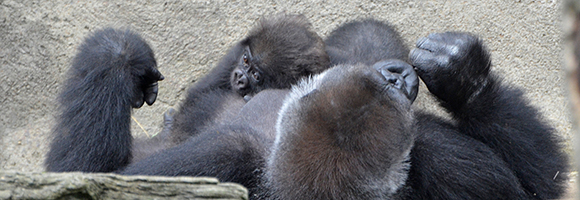Gladys Goes Outside with M’linzi & Mara
The Cincinnati Zoo’s 5-month-old Western lowland gorilla, Gladys, her new gorilla surrogate mother, M’Linzi and M’Linzi’s daughter, Mara, are now exploring the outside yard as a family for the first time.

“It was spectacular,” said Ron Evans, Cincinnati Zoo Primate Team Leader. “Mara actually carried Gladys outside first and toured Gladys around the yard tightly tucked onto her abdomen. Both Mara and M’Linzi were purring like crazy. Mara laid down a couple of times just relaxing with Gladys on her belly.”
Evans adds, “About 20 minutes into it, Mara put Gladys down on the rock surface – one texture that Gladys never had totally gotten used to – and she cried. M’Linzi immediately went to Gladys and Mara and took over surrogate duties. M’Linzi took her all over the yard including up into the tree. Gladys did great holding on.”
Cincinnati Zoo visitors can see Gladys, M’Linzi and Mara outside from 12:45p-3p every day, weather and behavior pending. Gladys’ appearances are tentative and may be canceled, shortened or rescheduled due to weather or due to critical stages in her introduction to her new gorilla family, that would require her to remain behind the scenes. Visitors can check the Zoo’s website daily to find out Gladys’ schedule.
Background
Cincinnati Zoo keepers raised Gladys around-the-clock for the past four months with a team of human surrogates. They taught Gladys to act and think like a gorilla. They fed Gladys, held her to their chest and carried her on their backs. They explored every nook of the exhibit areas, both inside and out, and were even seen knuckle-walking with Gladys in the yard. During their 8-hour shifts they wore all black scrubs and black faux fur vests, to imitate gorilla fur and they even vocalized like a gorilla, teaching Gladys exactly what the different sounds mean. [toggle title=”more info”]
Gladys was born January 29 at the Gladys Porter Zoo in Brownsville, Texas. After the birth, mother, 14 -year-old “Kiazi,” didn’t respond well and rejected the infant. This behavior, which occasionally happens in first-time mothers, resulted in keepers from the Gladys Porter Zoo stepping in to hand-rear the infant until they had a plan in place. Unfortunately, all of the viable surrogates there already had young gorillas, so they began to look elsewhere. After countless phone calls with the Gladys Porter Zoo, the Association of Zoos & Aquariums (AZA) Ape Taxon Advisory Group (TAG) Maternal Management Committee and the Western Lowland Gorilla Species Survival Plan (SSP) Committee, the Cincinnati Zoo was determined to be the best home for the baby.
M’Linzi was born at the Cincinnati Zoo on December 7, 1982. On August 13, 1995 M’Linzi gave birth to daughter “Mara” and was the perfect mother. M’Linzi has a laid back, non aggressive personality that aids her socialization. She has done well in any gorilla family over the last 31 years and is currently part of the Zoo’s silverback (“Jomo”) group and it is hoped that eventually she and Gladys will join this group. However, M’Linzi’s flexible social skills create many options for whatever scenario ultimately works out best for Gladys.
There are about 765 gorillas in zoos worldwide including approximately 360 in the AZA’s SSP. The Cincinnati Zoo is now home to eight Western lowland gorillas. Western lowland gorillas are critically endangered in the wild, with less than 175,000 individuals. Due primarily to habitat destruction caused by logging, mineral mining and agricultural expansion, wild gorilla numbers continue to shrink. The bushmeat trade – the killing of wild animals to be used as human food – is also a major threat to the western lowland gorilla population throughout the Central African rainforests. Over 1,000 gorillas are illegally poached for the bushmeat trade each year. The Cincinnati Zoo supports wild gorilla conservation efforts like the Mbeli Bai Study in Nouabalé-Ndoki National Park in the Republic of Congo. The Mbeli Bai Study is the longest running research being done with wild western lowland gorillas. Through research, local education programs, publications and documentaries, the Mbeli Bai Study is raising international awareness for gorillas and their struggle for survival. [/toggle]

